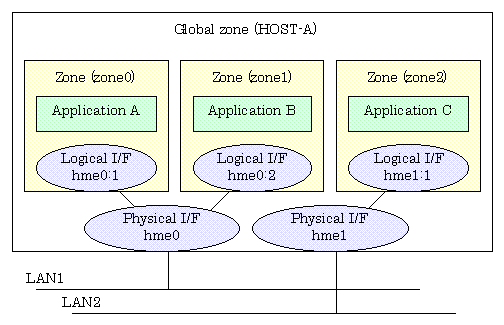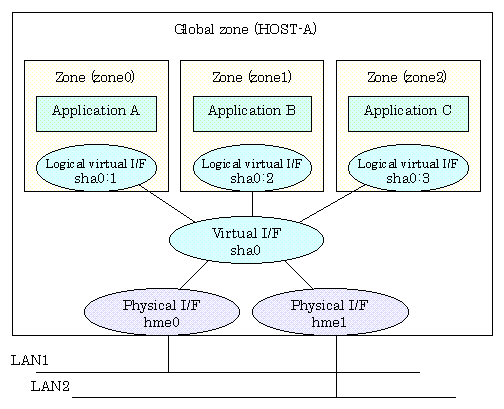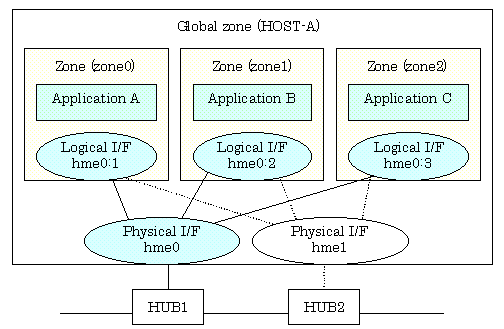

| PRIMECLUSTER Global Link Services Configuration and Administration Guide: Redundant Line Control Function 4.1 (for Solaris(TM) Operating System) |
Contents
Index
 
|
| Chapter 2 Feature description | > 2.3 Other functions |
Solaris containers are location independent and complete runtime environments for applications. Each application runs in its own private environment -- without dedicating new systems -- and many applications can be tested and deployed on a single server. Solaris Zones software partitioning technology provides a virtual mapping from the application to the platform resources. Zones allow application components to be isolated from one another even though the zones share a single instance of the Solaris Operating System. The Solaris Zones partitioning technology is used to virtualize operating system services and provide an isolated and secure environment for running applications. A zone is a virtualized operating system environment created within a single instance of the Solaris Operating System.
The virtual server is referred to simply as non-global zone (hereafter, zone). Every Solaris system contains a global zone. The global zone is both the default zone for the system and the zone used for system-wide administrative control. The redundant line control function ensures network high-reliaiblity on the zone.
One or more IP address is allocated to each zone of the Solaris container. The IP addresses are added to the logical interface generated on the physical interface. The logical interface is hidden from the other zones, so applications can only use the IP addresses (logical interface) allocated to the zone.
The following figure shows the network interfaces configuration example.

Starting each zone from the system (global zone) will enable the zone.

IP addersses (logical interfaces) allocated to each zone are created or deleted from Solaris OS along with zone startup or stop. If physical interfaces or virtual interfaces do not exist, the zone will not be started. If you make the zone network highly reliable through redundant line control, it is necessary to activate the virtual interface before zone startup. However, the redundant line control function will be first started during system startup, so users do not have to be aware of the startup order.
The following table describes how each redundant line control function corresponds to high-reliability and GLS command capability in the global or non-global zne of the Solaris container.
|
Redundant line control |
Solaris container |
||||
|
Global zone |
Non-global zone |
||||
|
High-reliablity |
GLS command |
High-reliablity |
GLS command |
||
|
Fast switching mode |
IPv4 |
Possible |
Possible |
Possible |
Not possible |
|
IPv6 |
Possible |
Possible |
Possible |
Not possible |
|
|
Dual |
Possible |
Possible |
Possible |
Not possible |
|
|
RIP mode |
IPv4 |
Possible |
Possible |
Not possible |
Not possible |
|
Fast switching / RIP mode |
IPv4 |
Possible |
Possible |
Not possible |
Not possible |
|
NIC switching mode |
IPv4 |
Possible |
Possible |
Not recommended |
Not possible |
|
IPv6 |
Possible |
Possible |
Possible |
Not possible |
|
|
Dual |
Possible |
Possible |
Possible |
Not possible |
|
|
NIC switching mode |
IPv4 |
Possible |
Possible |
Possible |
Not possible |
|
GS/SURE linkage mode |
IPv4 |
Possible |
Possible |
Not possible |
Not possible |

The following example shows how to configure the virtual and physical interfaces in fast switching mode.
The application in each zone communicates with each other using the logical/virtual interfaces that are allocated to the virtual interface. Even though an error occurs in the transmission route of the redundant physcail interface (hme0 or hme1), it will never disrupt ongoing operations.

The following example shows how to configure the virtual and physical interfaces in NIC switching mode.
The application in each zone communicates with each other using the logical interfaces that are allocated to the physical interfaces. Even though an error occurs in the transmission route of the redundant physcail interface (hme0), the applications will be switched over to the standby interface (Ihme1) and ensures operational continuity.


For details about the Solaris container, see the Solris 10 OS manual.
 2.3.6.1 Network high-reliability through redundant line control
2.3.6.1 Network high-reliability through redundant line control
Contents
Index
 
|